Linux系统编程---进程I/O
Posted 蚍蜉撼树谈何易
tags:
篇首语:本文由小常识网(cha138.com)小编为大家整理,主要介绍了Linux系统编程---进程I/O相关的知识,希望对你有一定的参考价值。
进程I/O
C语言下的文件接口使用
C语言文件描述
示例:
这里实验两个。
调用fwrite()函数–写入函数
1#include<stdio.h>
2 #include<string.h>
3 #include<stdlib.h>
4 int main()
5 {
6 FILE *fp=fopen("1.txt","w");
7 if(fp==NULL)
8 {
9 perror("create error");
10 exit(1);
11 }
12 char buf[256]="hello world\\n";
13 fwrite(buf,strlen(buf),1,fp);
14 fclose(fp);
15 return 0;
16 }
fwrite(buf,strlen(buf),1,fp); 为什么strlen不加1,
因为’\\0’只是字符串中的描述符,与文件无关,加上可能会造成乱码的情况。

fread()读取文件
1 #include<stdio.h>
2 #include<string.h>
3 #include<stdlib.h>
4 int main()
5 {
6 FILE *fp=fopen("1.txt","w");
7 if(fp==NULL)
8 {
9 perror("create error");
10 exit(1);
11 }
12
13 char buf[256]="hello world\\n";
14 fwrite(buf,strlen(buf),1,fp);
15 // fclose(fp);
16 fflush(fp);
17 fp=fopen("1.txt","r");
18 if(fp==NULL)
19 {
20 perror("open filed");
21 }
22 char cat1[100];
23 size_t k= fread(&cat1,1,sizeof(cat1),fp);
24 printf("%d\\n",k);
25 cat1[k]='\\0';
26
27 printf("%s",cat1);
28 fclose(fp);
29 return 0;
30 }
~
~
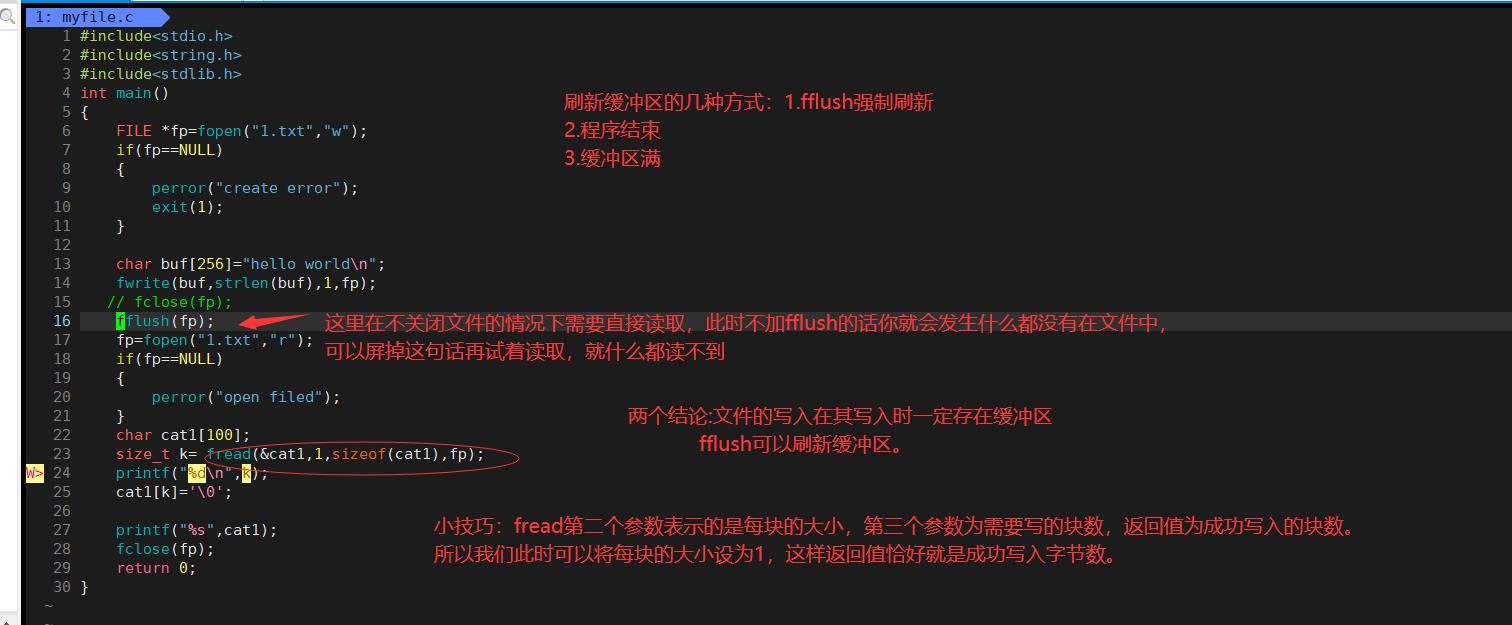

Linux 下的文件操作
打开文件
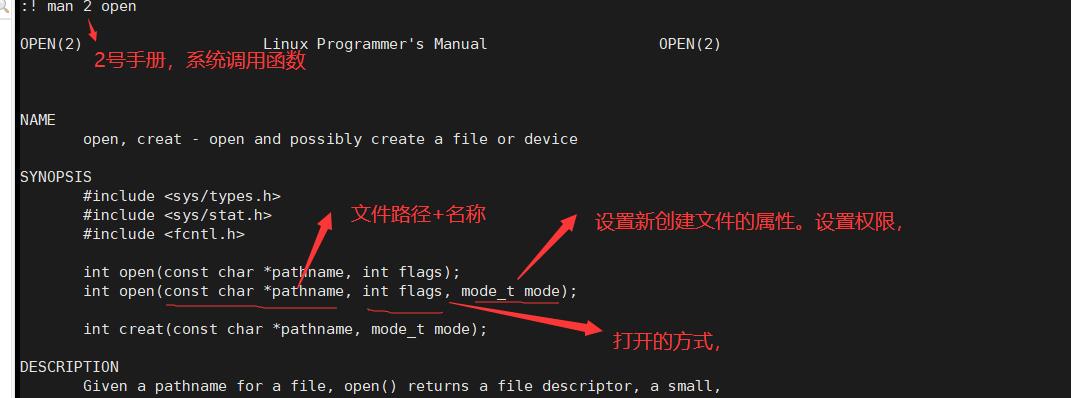
摘自:Linux 2.6.32内核
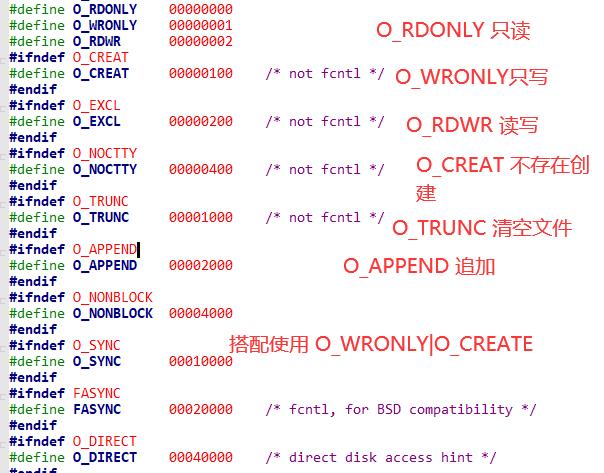
使用:
1 #include<stdio.h>
2 #include<sys/stat.h>
3 #include<sys/types.h>
4 #include<fcntl.h>
5 int main()
6 {
7 int fd=open("1.txt",O_RDONLY);
8 if(fd<0)
9 {
10 printf("open error");
11 return 1;
12 }
13 printf("%d\\n",fd);
14 return 0;
15 }

write函数

1 #include<stdio.h>
2 #include<sys/stat.h>
3 #include<sys/types.h>
4 #include<fcntl.h>
5 #include<string.h>
6 #include<unistd.h>
7 int main()
8 {
9 int fd=open("write.txt",O_WRONLY|O_CREAT,0664);
10 if(fd<0)
11 {
12 printf("open error");
13 return 1;
14 }
15 const char*str="hello Linux\\n";
16 write(fd,str,strlen(str));
17 printf("%d\\n",fd);
18 return 0;
19 }
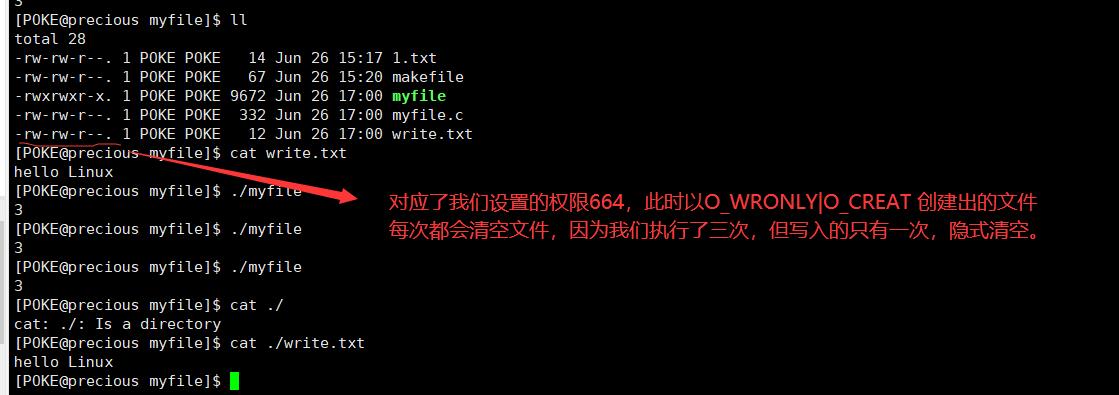
这里的O_WRONLY会在文件有内容的情况下隐式的清空我们的文件。还有一个O_TRUNC显式清空,我们这里试一下。
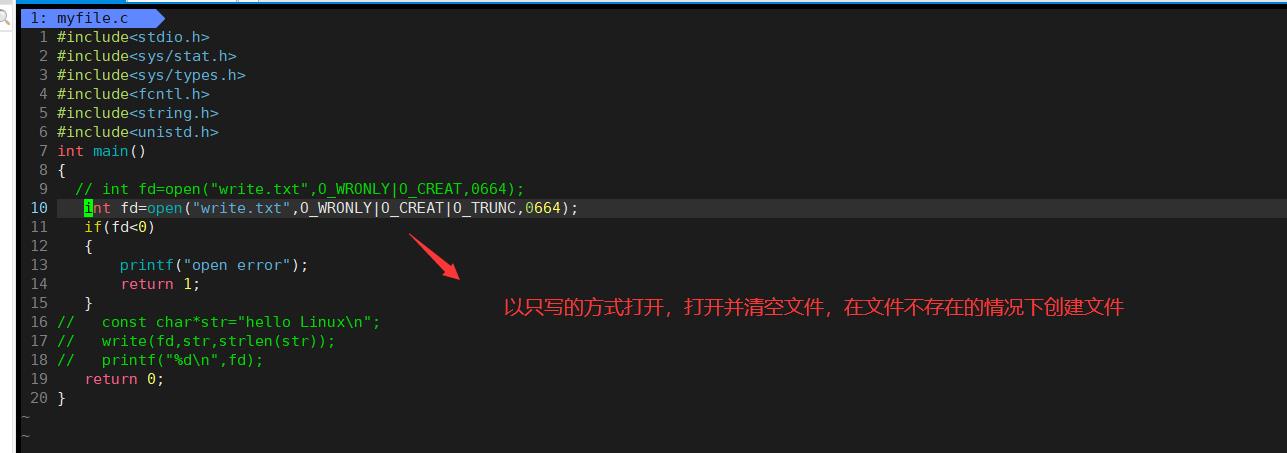
与之相对的,是O_APPEND 追加。
1 #include<stdio.h>
2 #include<sys/stat.h>
3 #include<sys/types.h>
4 #include<fcntl.h>
5 #include<string.h>
6 #include<unistd.h>
7 int main()
8 {
9 // int fd=open("write.txt",O_WRONLY|O_CREAT,0664);
10 // int fd=open("write.txt",O_WRONLY|O_CREAT|O_TRUNC,0664);
11
12 int fd=open("write.txt",O_WRONLY|O_CREAT|O_APPEND,0664);
13 if(fd<0)
14 {
15 printf("open error");
16 return 1;
17 }
18 const char*str="hello Linux\\n";
19 write(fd,str,strlen(str));
20 close(fd);
21 // printf("%d\\n",fd);
22 return 0;
23 }
~
执行三次后,有三个hello Linux被写入

文件描述符。

看第一次验证打开文件时open()函数的返回值为3,这里怎么理解它呢?

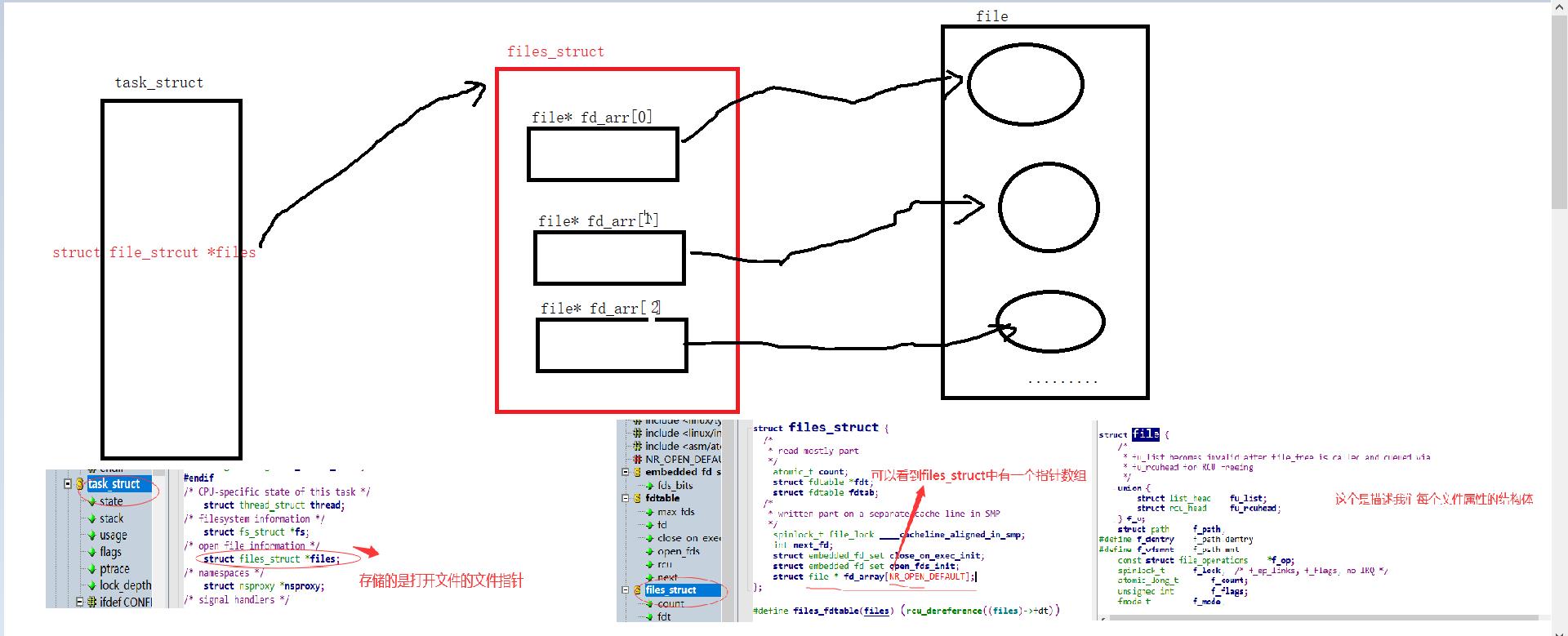
如何理解Linux下一切皆文件

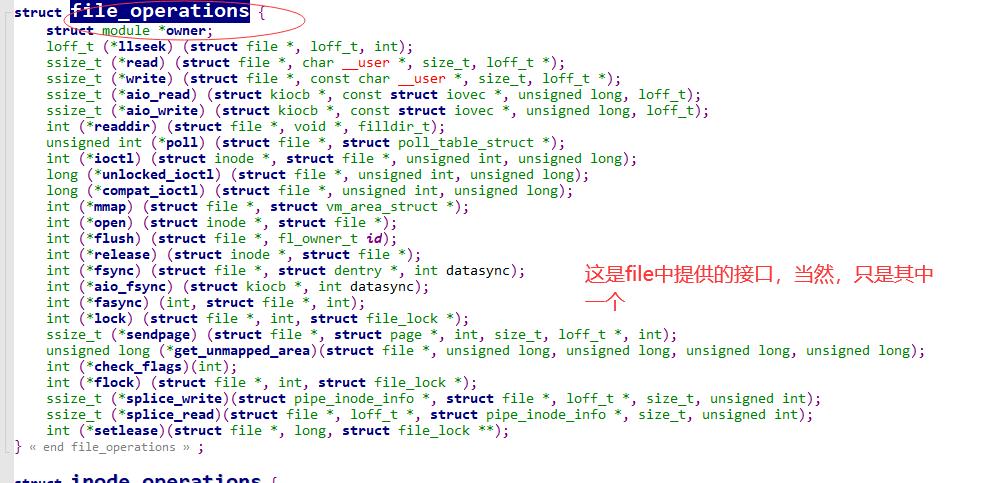
文件描述符的分配规则
默认从小到大进行分配
1 #include<stdio.h>
2 #include<sys/stat.h>
3 #include<sys/types.h>
4 #include<fcntl.h>
5 #include<string.h>
6 #include<unistd.h>
7 int main()
8 {
9 // int fd=open("write.txt",O_WRONLY|O_CREAT,0664);
10 // int fd=open("write.txt",O_WRONLY|O_CREAT|O_TRUNC,0664);
11
12 close(0);
13 int fd=open("write.txt",O_WRONLY|O_CREAT|O_APPEND,0664);
14 printf("%d\\n",fd);
15 int fd1=open("a.txt",O_CREAT|O_WRONLY,0664);
16 printf("%d\\n",fd1);
17 int fd2=open("b.txt",O_CREAT|O_WRONLY,0664);
18 printf("%d\\n",fd2);
19 sleep(1);
20 int fd3=open("c.txt",O_CREAT|O_WRONLY,0664);
21 printf("%d\\n",fd3);
22 //if(fd<0)
23 //{
24 // printf("open error");
25 // return 1;
26 //}
27 // const char*str="hello Linux\\n";
28 // write(fd,str,strlen(str));
29 // close(fd);
30 // // printf("%d\\n",fd);
31 return 0;
32 }

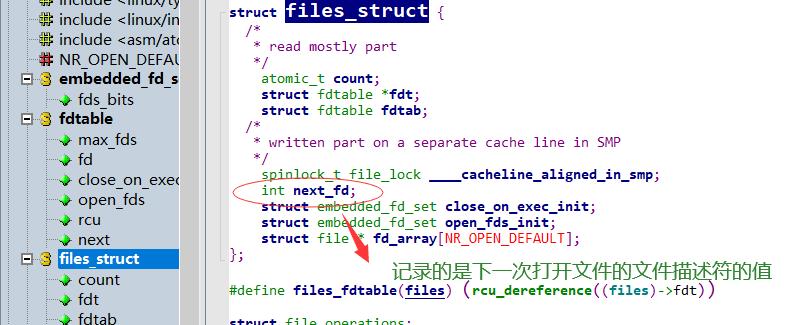
文件流指针FILE*与文件描述符的区别

重定向
把原本所要显示到当前文件中的内容输出到别的文件中去。

普通重定向
通俗的说,就是每次在重定向之前,若文件存在则清空该文件,然后执行写入,若不存在,则先创建文件,然后执行写入操作。
使用函数:

1 #include<stdio.h>
2 #include<sys/types.h>
3 #include<sys/stat.h>
4 #include<fcntl.h>
5 #include<unistd.h>
6 int main()
7 {
8 int fd=open("redirect.txt",O_CREAT|O_WRONLY|O_TRUNC,0664);
9 if(fd<0)
10 {
11 perror("open failed");
12 return 1;
13 }
14 dup2(3,1);
15 close(fd);
16 printf("hello Linux\\n");
17 printf("hello young man\\n");
18 printf("hello oc\\n");
19 return 0;
20 }
21
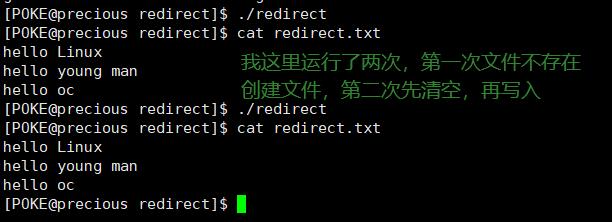
追加重定向
与普通重定向相比来说,其类似于就是文件的追加,不清空文件。

相对于普通重定向来说,我们只需要将其的打开文件的方式由O_TRUNC变为O_APPEND 即可
1 #include<stdio.h>
2 #include<sys/types.h>
3 #include<sys/stat.h>
4 #include<fcntl.h>
5 #include<unistd.h>
6 int main()
7 {
8 // int fd=open("redirect.txt",O_CREAT|O_WRONLY|O_TRUNC,0664);
9 int fd=open("redirect.txt",O_CREAT|O_WRONLY|O_APPEND,0664);
10 if(fd<0)
11 {
12 perror("open failed");
13 return 1;
14 }
15 dup2(3,1);
16 close(fd);
17 printf("hello Linux\\n");
18 printf("hello young man\\n");
19 printf("hello oc\\n");
20 return 0;
21 }
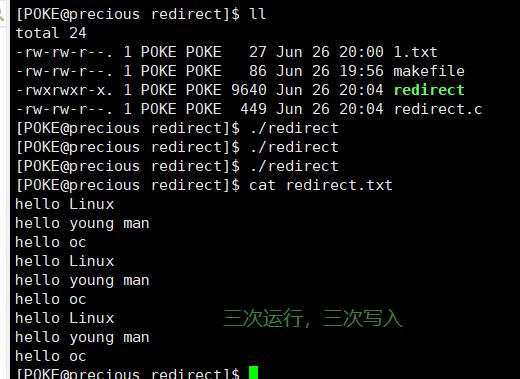
重定向的本质
将其stdout文件的指向由之前的指向变为新创建的文件,(通俗点说,要么你关闭掉1号文件,1号文件就是stdout,然后重新打开新文件,则根据文件描述符的分配方式,则会将1分配给新打开的文件,这时候执行程序的话,将本该打印在屏幕上的数据输出到了你新打开的文件。 第二种方式调用dup2(int newfd,int oldfd).将newfd拷贝给oldfd,其本质也是更改1号文件的指向。
缓冲区
为什么要引入缓冲区?
因为cpu的处理速度是远远大于I/O操作的,所以我们再写入或是读取的时候,都会先将写入或者读取的数据放在一块缓冲区内,等cpu执行完后,用户再去取数据,或者用户先写入到缓冲区,然后由cpu直接去读取。
本质:空间换时间,匹配cpu与I/O差异的情况。
缓冲区归属
我们在学习C/C++中都听到过缓冲区的概念,那么缓冲区位于什么地方,它到底是属于语言层面的缓冲区还是属于系统层面的缓冲区?
1 #include<stdio.h>
2 #include<sys/stat.h>
3 #include<sys/types.h>
4 #include<fcntl.h>
5 #include<string.h>
6 #include<unistd.h>
7 int main()
8 {
9 close(1);
10 const char*str1="hello Linux\\n";
11 const char*str2="hello world\\n";
12 const char*str3="hello peter\\n";
13 int fd=open("buf.txt",O_WRONLY|O_CREAT|O_APPEND,0664);
14 if(fd<0)
15 {
16 perror("create err");
17 return 1;
18 }
19 write(1,str1,strlen(str1));
20 printf("%s",str2);
21 fprintf(stdout,"%s",str3);
22 fork();
23 fflush(stdout);
24 return 0;
25 }
此时在子进程中会被刷新一次,父进程中也会刷新一次。

原因:在刷新过程中只对库函数的写入刷新了两次,系统调用只写入一次。
常见的缓冲方式
1、全缓冲
在这种情况下,当填满标准I/O缓存后才进行实际I/O操作。全缓冲的典型代表是对磁盘文件的读写。
2、行缓冲
在这种情况下,当在输入和输出中遇到换行符时,执行真正的I/O操作。这时,我们输入的字符先存放在缓冲区,等按下回车键换行时才进行实际的I/O操作。典型代表是键盘输入数据。
3、不带缓冲
也就是不进行缓冲,标准出错情况stderr是典型代表,这使得出错信息可以直接尽快地显示出来。
理解文件系统
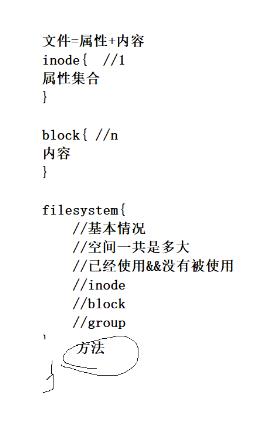
操作系统会将我们的磁盘的管理抽象为对数组的管理。地址映射,根据逻辑地址计算物理地址。
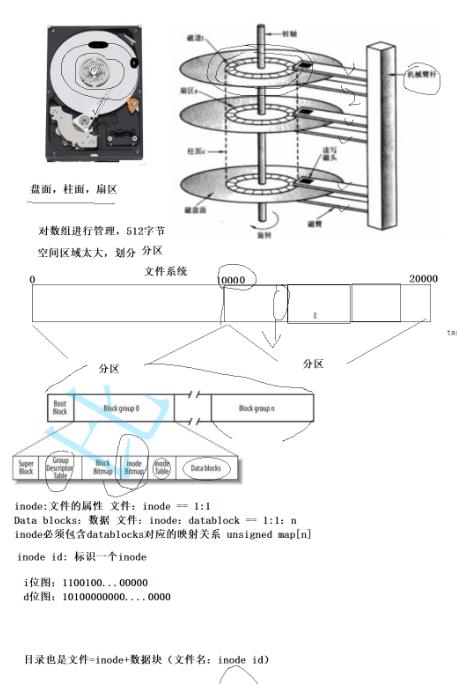
Block Group :ext2文件系统会根据分区的大小划分为数个Block Group。而每个Block Group都有着相同的结构组成。政府管理各区的例子
超级块(Super Block):存放文件系统本身的结构信息。记录的信息主要有:bolck 和 inode的总量,未使用的block和inode的数量,一个block和inode的大小,最近一次挂载的时间,最近一次写入数据的时间,最近一次检验磁盘的时间等其他文件系统的相关信息。Super Block的信息被破坏,可以说整个文件系统结构就被破坏了GDT,
Group Descriptor Table:块组描述符,描述块组属性信息,有兴趣的可以在了解一下
块位图(Block Bitmap):Block Bitmap中记录着Data Block中哪个数据块已经被占用,哪个数据块没有被占用
inode位图(inode Bitmap):每个bit表示一个inode是否空闲可用。
i节点表:存放文件属性 如 文件大小,所有者,最近修改时间等
数据区:存放文件内容
位图:Inode Bitmap:表示该inode有没有被分配出去。这个表标识了有哪些inode被使用,有多少个inode没有被使用。
Block Bitmap:标识了有哪些块已经被使用,哪些块没有被使用。
怎么创建一个文件:首先在inode Bitmap中找到一块未被分配的内存,创建完后再去Block Bitmap中选取相应的内存。
怎么找一个文件:首先确定分区,再查找Inode Bitmap位图找到对应的inode号,接下来根据里面存储的文件所在地方去找文件即可。
问答题:在磁盘容量充足的情况下,创建文件失败,为什么?
这种情况是存在的,因为文件系统自创建起其inode Bitmap 中所能创建的最大的inode 个数已经确定了,此时虽然说你有容量,但是在inode Bitmap这个位图中已经没有多余的空间供你去记录你文件的信息了,所以此时尽管你有空间,你也不能创建文件。
如何理解删除文件?
删除文件是不是将文件删除(物理上的),不是的,因为你会发现你下载的时间可能很长,但删除的时间却很短。为甚么会这样,这是因为在删除时操作系统首先会找到文件,然后将你的文件的inode从inode Bitmap中置0,标识这部分空间没有被使用。相应的,在Block Bitmap中同样的,也会将这文件对应的 data Blocks 从位图中置0。这样在肉眼上你确实看到你文件不见了,同时磁盘可用容量也变多了。
如何恢复删除的文件?
在没有文件覆盖删除文件的inode的情况下,我们可以去inode Table中去查找,其中仍然记录着与data Block 之间的映射关系,此时去找的话我们就可以找到对应的块。本质便是先将它里面的inode Bitmap 中的inode置为1,然后通过映射关系将其data Block对应的 Block Bitmap 置为1。
理解目录
目录也是文件=inode+数据块(文件名:inode id)
理解ls命令:

理解ls -al

通过ls -i查看对应关系。

软硬链接
软链接
软链接又称之为符号连接(Symbolic Link)。软链接文件类似于Windows的快捷方式。它实际上是一个特殊的文件。在符号连接中,文件实际上是一个文本文件,其中包含的有另一文件的位置信息。
软链接文件的特性
生成软链接文件: ln -s 源文件名 生成文件名
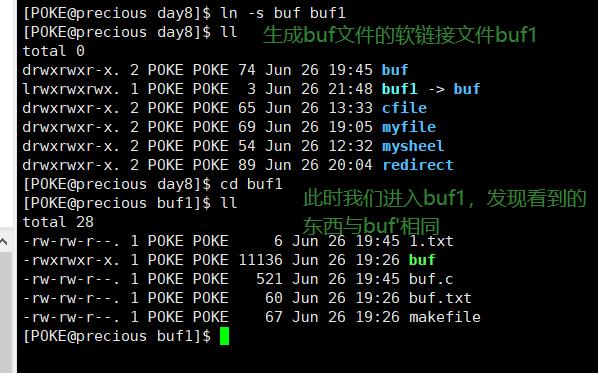

软链接的使用
1.作为启动程序的快捷方式
首先创建一个软链接文件
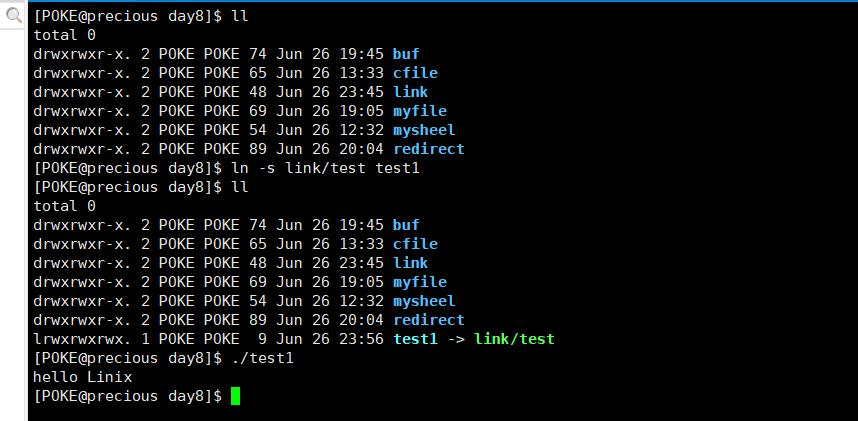
1 #include<stdio.h>
2 int main()
3 {
4 printf("hello Linix\\n");
5 return 0;
6 }
软链接的使用注意
1.软链接文件会随着源文件的修改在变
2.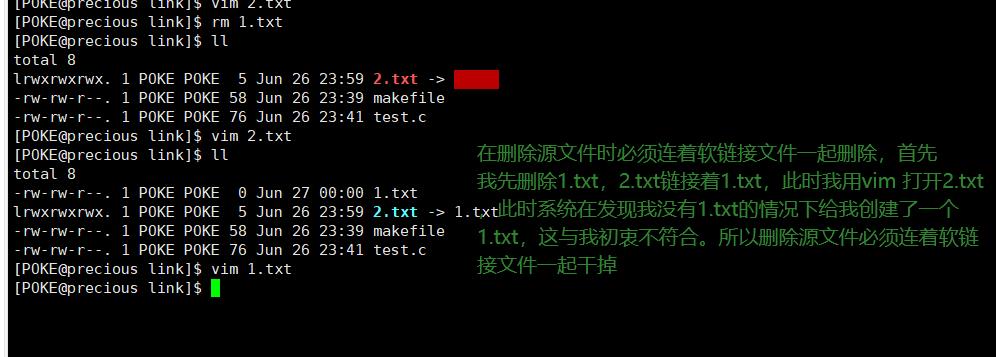
硬链接
语法:
ln 源文件 硬链接文件
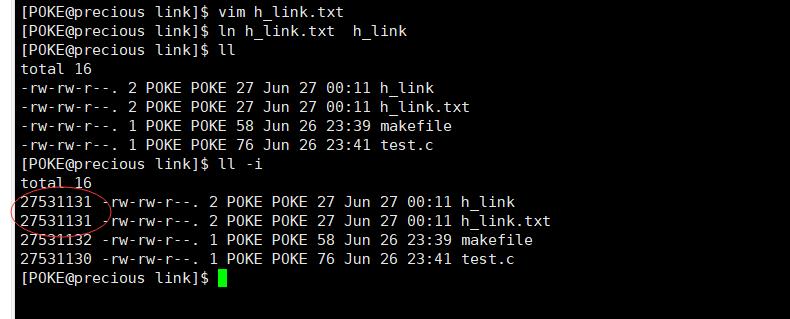
如上图可以看到硬链接文件不是一个独立的文件。因为硬链接文件没有独立的inode。
硬链接的使用
类似于windows下的重命名,重命名可以看作是先生成一个硬链接文件,然后删除源文件,则这个硬链接文件便是 重命名之后的文件。
理解ll命令

1.模式
2.硬链接数
3.文件所有者
4.组
5.大小
6.最后修改时间
7.文件名

软硬链接的区别是软链接具有独立的inode,硬链接与链接文件共有一个inode。
动静态库
静态链接与动态链接生成可执行文件
测试用例:

makefile文件
1 all:test teststatic
2 test:test.c
3 gcc $^ -o $@
4 teststatic:teststatic以上是关于Linux系统编程---进程I/O的主要内容,如果未能解决你的问题,请参考以下文章